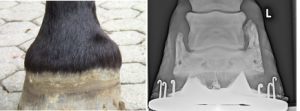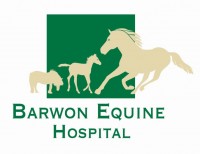The collateral cartilages attach to the wings of the pedal bone. They form a bowl like structure the heels, extending from within the hoof capsule to just above the coronary band, on either side of the digital cushion. When the cartilage is replaced by bone, it is known as sidebone. It may result in the formation of a bony lump on either side of the coronary band in the heel region. Sidebone is typically an incidental finding and generally causes no lameness.

There are several possible causes. Most common is age-related degeneration. Draught breeds have a slightly higher predisposition, which is thought to be a result of their high body weight, which leads to higher concussive forces within the hoof. In younger, lighter horses, sidebone is associated with one or several of the following causes:
- Imbalance within the hoof, leading to increased loading and concussion of one or both cartilages. Poor conformation or errors in trimming and shoeing can contribute.
- Frequent fast work on hard ground
- Genetic causes are also suspected, as sidebone has been observed in some young horses that have yet to be worked.
Lameness caused by sidebone is rare. However, in advanced cases, where the ossification is extensive, sidebone may impinge on sensitive structures in the hoof and cause mild lameness, pain on turning and tenderness on palpation. Occasionally, sidebone may fracture, also resulting in lameness and pain on turning. Often sidebone as a cause of lameness is a diagnosis of exclusion.
X-rays will reveal the extent of the ossification in some cases the presence of a fracture. Scintigraphy can be helpful in making a definitive diagnosis, as this may show whether there is any active inflammation.
Once ossification has started, it is difficult to prevent progression. The most important factor is to prevent any inciting factors i.e. imbalance in the foot. A rolled toe show will help ease breakover, and the support given to the frog through a bar shoe or a suitable pad can help redistribute pressure from the heel to the frog.
Once lameness subsides, the horse can return to work. Extreme concussive forces may not be tolerated and the rider should endeavour to exercise the horse on soft ground.
